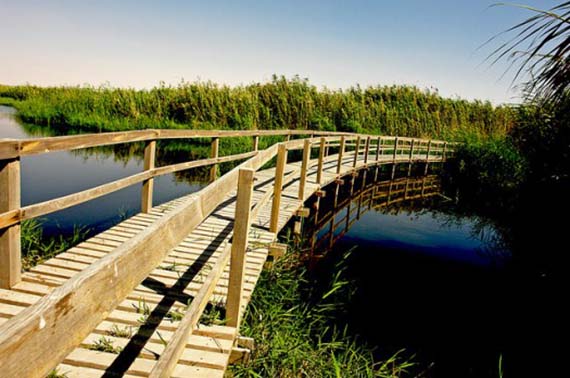Azraq Wetland Reserve
Azraq is a unique wetland oasis located in the heart of the semi-arid Jordanian eastern desert, one of several beautiful nature reserves managed by the RSCN. Its attractions include several natural and ancient built pools, a seasonally flooded marshland, and a large mudflat know as Qa’a Al-Azraq. A wide variety of birds stop at the reserve each year for a rest during their arduous migration routes between Asia and Africa. Some stay for the winter or breed within the protected areas of the wetland.
Visiting the Reserve
An ideal spot for admiring the flocks in flight is bird watching reachable through a wooden path that runs along part of the marsh. The sensation of being immersed in this water paradise surrounded by the desert is unique. The oasis hosts also mammal species including water buffaloes, a species that is essential for the maintenance of wetlands.
Guided visits of the site can be booked at the Visitor Centre. The visitor centre also offers informative panels narrating the Azraq oasis project and describing the flora and fauna. The best time to visit the oasis is winter or early spring when the natural pools are fed by winter rains.
A Story of an Irreversible Ecological Disaster
The Azraq Wetland Reserve is all that remains of the vast Azraq reservoir, which during prehistoric times extended over an area larger than Lebanon, hosting thousands of animals, including elephants, cheetahs, and hippos. From the 1960s, that infamous (but in many ways necessary) pumping activities took place in the area to supply Jordan with drinking water. The whole area was soon turned into barren land. The permanent groundwater resources of the subsoil were consumed to the point of no return and the local grazing and fires destroyed the vegetation leading to a dramatic decrease in the number of birds visiting the region.
In the 1970s, Jordan signed the Ramsar Convention on Wetlands of International Importance, especially as Waterfowl Habitat. The remains of the once permanently submerged land were declared a protected area and the main ponds were dredged and the water was pumped back through irrigation ducts. Gradually, the birds have returned to the area, although to a much lesser extent than in the past.
